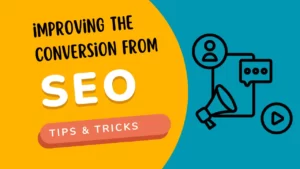A good user experience is crucial in today’s digital age, where users have high expectations for the products and services they use. In today’s digital age, where almost all businesses have an online presence, it’s essential to ensure that your website is optimized not only for search engines but also for the user experience. While search engine optimization (SEO) and user experience (UX) are often considered separate entities, they’re both critical to the success of a website. In this article, we’ll explore what UX SEO is and how UX impacts SEO.
What is User experience (UX)?
User experience (UX) refers to the overall experience that a user has when interacting with a product, service, or system, such as a website or mobile app. It encompasses all aspects of the user’s interaction, including how easy it is to navigate, how visually appealing it is, and how well it meets the user’s needs and expectations. A positive user experience can lead to increased user satisfaction, repeat visits, and higher engagement rates, while a poor user experience can lead to frustration, negative reviews, and lost customers.
To create a good user experience, designers and developers must consider the user’s needs, goals, and preferences. This involves conducting user research, such as surveys and usability tests, to understand the user’s behavior and preferences. Based on this research, designers can create user personas, which represent typical users, and use them to guide the design process.
The design process for creating a good user experience typically involves the following steps:
- Research: This involves gathering information about the user’s needs, goals, and preferences.
- User personas: Based on the research, designers create user personas to represent typical users.
- Information architecture: This involves organizing the content and features of the product or service in a logical and intuitive way.
- Wireframes and prototypes: Designers create wireframes and prototypes to test and refine the design.
- User testing: This involves testing the design with real users to identify any issues and make improvements.
Iteration: Based on the results of user testing, designers make improvements and iterate on the design.
What is UX SEO?
UX SEO refers to the practice of optimizing a website for both search engines and user experience. It involves ensuring that a website is easy to use, engaging, and provides value to the user while also being structured and organized in a way that is easily crawled and understood by search engines.
UX SEO involves a combination of techniques that focus on optimizing the user experience and the website’s technical aspects to improve its visibility and ranking in search engines. Some of the techniques used in UX SEO include:
- Site structure and organization: This involves organizing the website’s content in a logical manner to make it easy for users to navigate and search engines to crawl.
- Page speed: A website’s page speed is a critical factor that impacts both user experience and search engine ranking. Slow-loading pages can frustrate users and lead to higher bounce rates, while search engines also take page speed into account when ranking websites.
- Content optimization: Creating high-quality content that provides value to users and is optimized for search engines is critical to UX SEO. This includes using keywords, optimizing headings and subheadings, and ensuring the content is easy to read and understand.
- User engagement: Encouraging user engagement, such as comments, shares, and social media activity, can help improve the website’s visibility and ranking in search engines.
How Does UX Impact SEO?
Search engines like Google prioritize user experience and have incorporated various user experience factors into their ranking algorithms. Some of the ways UX impacts SEO include:
- Bounce rate: When users leave a website after viewing only one page, it’s known as a bounce. A high bounce rate indicates that users aren’t finding what they’re looking for on the website, which can negatively impact SEO.
- Dwell time: Dwell time is the amount of time users spend on a website after clicking on a search result. A longer dwell time indicates that users are finding the website valuable, which can positively impact SEO.
- Mobile responsiveness: As mentioned earlier, search engines prioritize mobile-friendly websites, so having a mobile-responsive website can positively impact SEO.
- Page speed: Slow-loading pages can frustrate users and lead to higher bounce rates, which can negatively impact SEO.
- User engagement: User engagement, such as social media activity and comments, can indicate that users find the website valuable, which can positively impact SEO.
Common Goals In UX and SEO
UX and SEO share a common goal of improving the user’s experience with a website or digital product. By optimizing for both UX and SEO, businesses can attract more visitors, keep them engaged, and ultimately drive more conversions. Some of the common goals of UX and SEO include:
- User satisfaction: Both UX and SEO aim to create a positive user experience that meets the user’s needs and expectations. By understanding the user’s behavior, preferences, and goals, designers can create a website that is easy to use, engaging, and visually appealing.
- Accessibility: Both UX and SEO prioritize accessibility, ensuring that all users, regardless of their abilities or disabilities, can access and use the website. This includes optimizing for screen readers, using alt tags for images, and ensuring that the website is keyboard accessible.
- Page speed: Both UX and SEO recognize the importance of page speed in providing a good user experience and improving search engine rankings. Slow-loading pages can frustrate users and lead to higher bounce rates, while search engines also take page speed into account when ranking websites.
- Content quality: In UX SEO prioritize high-quality content that provides value to the user. This includes using keywords, optimizing headings and subheadings, and ensuring the content is easy to read and understand.
- User engagement: Both UX and SEO recognize the importance of user engagement in creating a positive user experience and improving search engine rankings. Encouraging user engagement, such as comments, shares, and social media activity, can help improve the website’s visibility and ranking in search engines.
What Ranking Factor You Should Consider in UX SEO?
In UX SEO, there are several ranking factors to consider that focus specifically on the user experience. These factors include:
- Page speed: As mentioned earlier, page speed is an important ranking factor in SEO. In UX SEO, it’s also essential to consider how page speed impacts the user experience. Slow-loading pages can frustrate users and lead to higher bounce rates, negatively impacting the user experience.
- Mobile-friendliness: In addition to being a ranking factor in SEO, having a mobile-friendly website is crucial in providing a positive user experience. With the majority of internet usage now happening on mobile devices, it’s essential that websites are optimized for mobile for better UX SEO.
- Navigation: Clear and easy-to-use navigation is an important factor in providing a positive user experience. Websites should be designed with the user in mind, making it easy for them to find what they’re looking for and navigate around the website.
- Accessibility: Ensuring that all users, regardless of their abilities or disabilities, can access and use the website is important in providing a positive user experience. This includes optimizing for screen readers, using alt tags for images, and ensuring that the website is keyboard accessible.
- Visual design: A visually appealing design is important in providing a positive user experience. Websites should be designed to be visually appealing and easy to read, with clear typography and appropriate use of color.
Final Thoughts:
UX SEO is essential for improving the visibility and ranking of a website in search engines while also providing a positive user experience. By optimizing a website’s technical and user experience (UX SEO) aspects, businesses can attract more visitors, engage with their audience, and ultimately drive more conversions.



